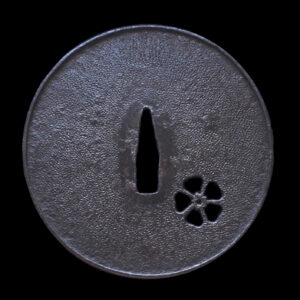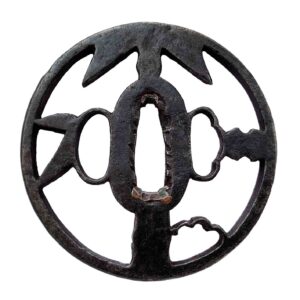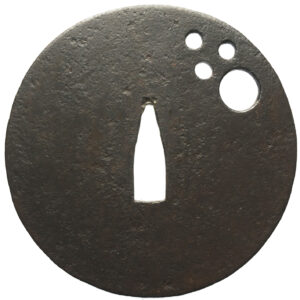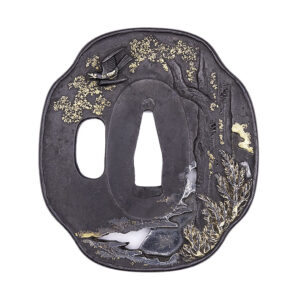This Tsuba by the first Master of the Higo Kamiyoshi school Juhei has a Hakogaki by Sasano Masayuki and is published in the book ‘Sukashi Tsuba in European collections’ by Prof. Eckhard Kremers. We will cite from the book in the following.
Juhei’s early guards are often more filigree than those of his son Fukanobu and his grandson Rakuju, and this is why they more closely resemble the late Hayashi school.
On the orders of the daimyo Hosokawa Tadayoshi, Kamiyoshi Juhei (1754-1820) and his successors had to follow the style of the Hayashi family, thus cultivating their tradition. The first master, not having left any signed pieces is difficult to be classified properly in respect to his style. Some guards which, according to written tradition are ascribed to him, must therefore serve as pieces of reference, his creations thus resembling those of the third and the fourth Hayashi masters. Design, surface treatment and patina of the latter are as perfect as those of the guards of his son Fukanobu and his grandson Rakuju. Though often adopting Hayashi motifs and designs, Kamiyoshi Tsuba are more recent and more generous in appearance which, amoung other aspects, is partly due to the large seppa-dai.
By means of the characteristic tagane on the head and the bottom of the nakago-ana, works are easily to be attributed to a master, even if they lack signing. These tagane vary in size from on e master to the next. Whereas Juhei drives two medium-sized, square-headed tagane into the upper part and five medium-sized ones into the bottom, his son’s guards exhibit four in the upper and seven small tagane in the lower end.
This piece exhibits the perfect dense surface and patina which is expected from Tsuba from the Kamiyoshi school. The design is carved very exact yet the dynamic and loose composition creates a nice contrast with the perfect carving.
The design is called ‘sagaru sakura’ which translates as hanging cherry blossoms. These kind of cherry trees are regarded as the most beautiful during the Sakura season in Japan.
H: 79 mm
W: 75 mm
R: 4.5 mm
Sd: 5.3 mm
















